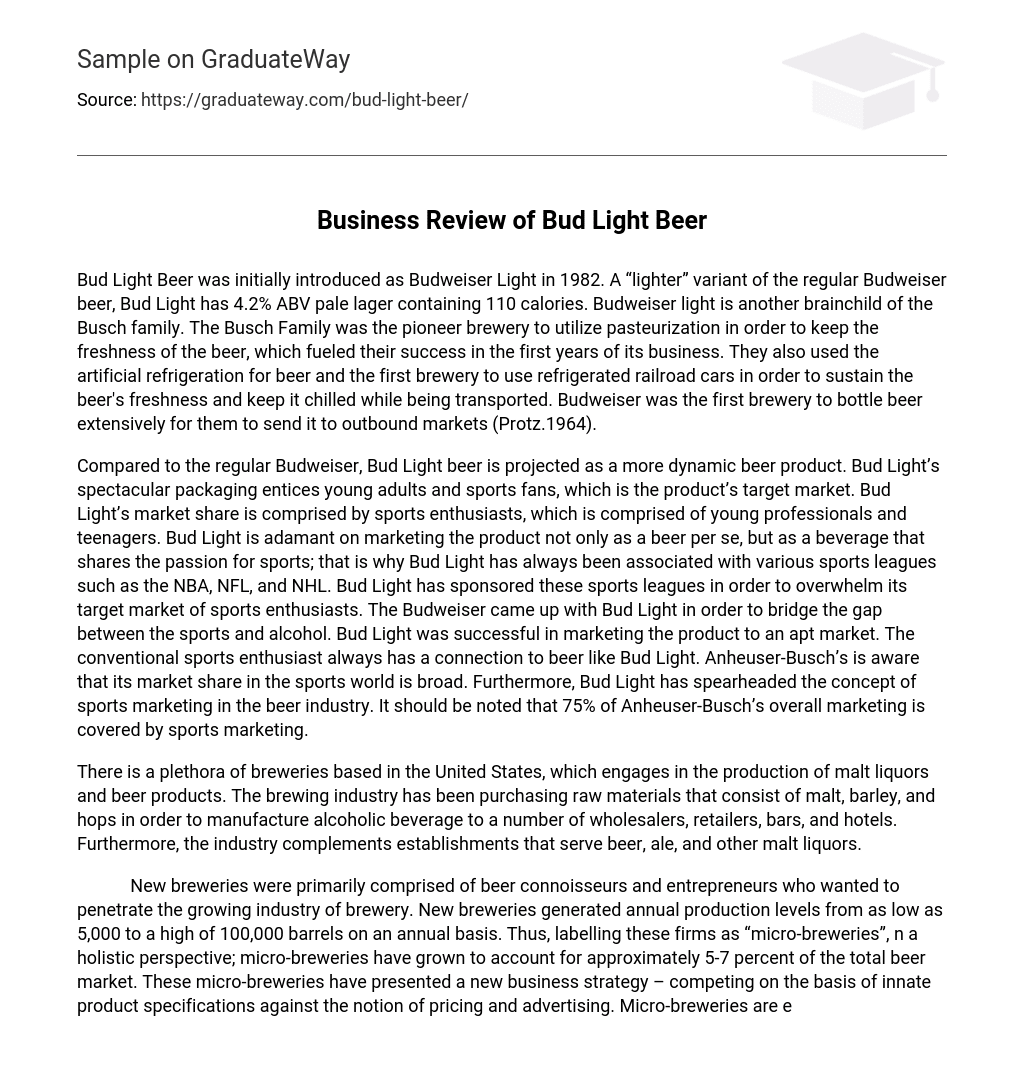Bud Light Beer was initially introduced as Budweiser Light in 1982. A “lighter” variant of the regular Budweiser beer, Bud Light has 4.2% ABV pale lager containing 110 calories. Budweiser light is another brainchild of the Busch family. The Busch Family was the pioneer brewery to utilize pasteurization in order to keep the freshness of the beer, which fueled their success in the first years of its business. They also used the artificial refrigeration for beer and the first brewery to use refrigerated railroad cars in order to sustain the beer’s freshness and keep it chilled while being transported. Budweiser was the first brewery to bottle beer extensively for them to send it to outbound markets (Protz.1964).
Compared to the regular Budweiser, Bud Light beer is projected as a more dynamic beer product. Bud Light’s spectacular packaging entices young adults and sports fans, which is the product’s target market. Bud Light’s market share is comprised by sports enthusiasts, which is comprised of young professionals and teenagers. Bud Light is adamant on marketing the product not only as a beer per se, but as a beverage that shares the passion for sports; that is why Bud Light has always been associated with various sports leagues such as the NBA, NFL, and NHL. Bud Light has sponsored these sports leagues in order to overwhelm its target market of sports enthusiasts. The Budweiser came up with Bud Light in order to bridge the gap between the sports and alcohol. Bud Light was successful in marketing the product to an apt market. The conventional sports enthusiast always has a connection to beer like Bud Light. Anheuser-Busch’s is aware that its market share in the sports world is broad. Furthermore, Bud Light has spearheaded the concept of sports marketing in the beer industry. It should be noted that 75% of Anheuser-Busch’s overall marketing is covered by sports marketing.
There is a plethora of breweries based in the United States, which engages in the production of malt liquors and beer products. The brewing industry has been purchasing raw materials that consist of malt, barley, and hops in order to manufacture alcoholic beverage to a number of wholesalers, retailers, bars, and hotels. Furthermore, the industry complements establishments that serve beer, ale, and other malt liquors.
New breweries were primarily comprised of beer connoisseurs and entrepreneurs who wanted to penetrate the growing industry of brewery. New breweries generated annual production levels from as low as 5,000 to a high of 100,000 barrels on an annual basis. Thus, labelling these firms as “micro-breweries”, n a holistic perspective; micro-breweries have grown to account for approximately 5-7 percent of the total beer market. These micro-breweries have presented a new business strategy – competing on the basis of innate product specifications against the notion of pricing and advertising. Micro-breweries are expected to be a possible threat to Bud Light by the time it comes up with alternative products for beer products associated with sports (Baron, 2002).
Bud Light has been successful so far in marketing its product to its target market and potential target segments. The Bud Light brand has made the Budweiser Company increase its profit margins with its effective sports marketing; making Bud Light synonymous to sports events, sports leagues, and most importantly – the fans. With this in mind, Bud Light is expected to generate more revenues as it continues to be associated with a plethora of sports leagues.
References
Budweiser. 2007. History of Budlight. Retrieved February 1, 2008, from Budlight.com
Protz,R. 1951. History of Beers. Encyclopedia of Beers.
Baron, S.(2000). Brewed In America: A History of Beer and Ale in the United States.





